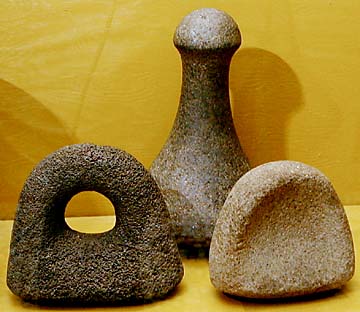

Prehistory to 1780: Ancient Hawaii to
Western Discovery

Tools: No metals meant high dependence on wood and stone. The people were expert in the characteristics of varied woods: Hard koa and breadfruit, for instance, were used for canoe hulls; milo was popular for small bowls. The Hawaiian way
Common wood items: bowls, spears, paddles. Rock poi pounders, hard-basalt adzes and chisels were oft-used tools.
Agriculture: Food wasn't just sustenance. Every step of agricutlure -- planting, tending crops, harvesting -- was tied to religion, customs and ceremony. The main foods: taro and poi, breadfruit, sweet potato, bananas. Also, vegetables, limu, fish, chicken, pig, dog and sugar cane. Most cooking was done in an imu, or underground oven.
In determining the right time to plant, the ancients followed phases of the moon. Their knowledge of celestial movements was used not only as their calendar, but also to navigate sea voyages.
Religion: In addition to the aumakua (family gods) and lesser gods like Pele the volcano goddess and Laka the hula deity, Hawaiians worshipped the four akua, the greater gods of nature. They were:
Kane: Creator of heaven, Earth, and all living things.Religion was an integral part of the society's belief, kapu and rank systems.Lono: God of rain and agriculture, and of peace. During the annual makahiki feast in his honor, October through February, war was kapu.
Ku: God of war, to whom human sacrifices were made.
Kanaloa: God of the ocean and ocean winds.
Mele and hula: Since there was no written language, everything from history to rituals was passed down in the oral tradition, making mele (song) a vital means of communication. Hula (dance) was an expression of religious worship and had sacred meanings.
Medicine: Herbs were used in healing. Among plants still used today:
Noni: Reputed to have healing powers, its leaf is used for boils and other injuries.Also, there was physiotherapy in the form of lomilomi (chiropractic massage), steam baths, and ti-leaf wrappings.Laukahi and pohe: For boils.
Kokea: White sugar cane for colds.
Ohia bark: For sore throats.
Fiberwork and featherwork: Pandanus or hala leaves were woven into items like mats, baskets and sandals. Other common plants: coconut leaves and husks, hau and ti.
Clothing was made from tapa (kapa), the thinly beaten bark of the paper mulberry, mamake, breadfruit or other member of the nettle family.
The ahuula, or feathercloak, was worn by high-ranking chiefs at special events. It was a network of woven olona fiber binding tight rows of feathers. Helmets, kahili and lei were also made of feathers.
Land: The islands were divided into mokus (districts), with boundaries running from the top of the mountains to the sea. Large districts were subdivided into smaller ones, ahupuaas. An ahu or altar was placed at the district boundary and each year during makahiki, offerings and payments were made.
A special site with religious and legal protection was a "city of refuge," sacrosanct lands on which no blood was shed. Ruling chiefs' "life-saving edicts" (pu'uhonua ho'ola) essentially extended the sacred space around an alii to the kapu site. The only surviving "City of Refuge" is at Honaunau on the Big Island's west side.
Sources: "Ancient Hawaiian Civilization," "Hawaii
and its Gods," Hawaiian Antiquities," and "The Hawaiian Canoe."
Millennium Series Archive